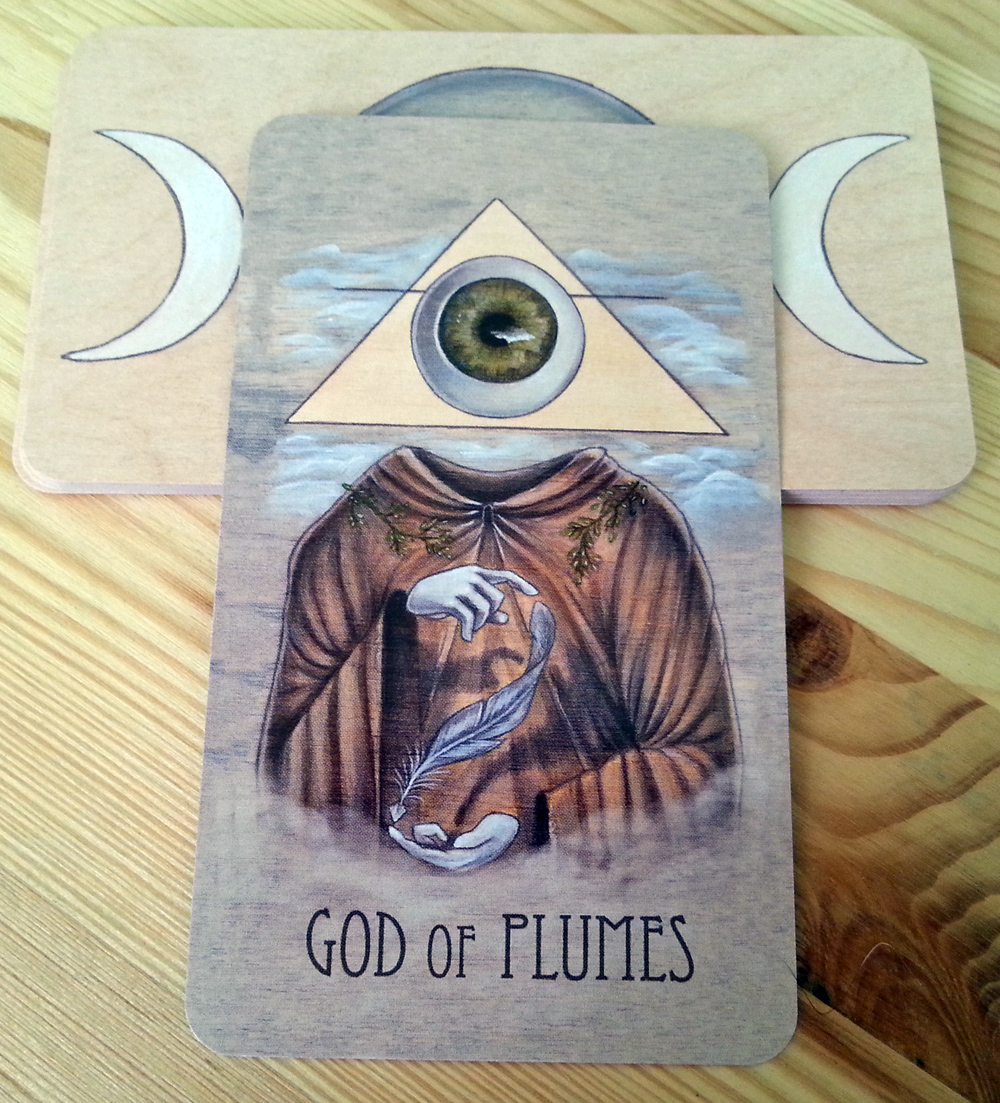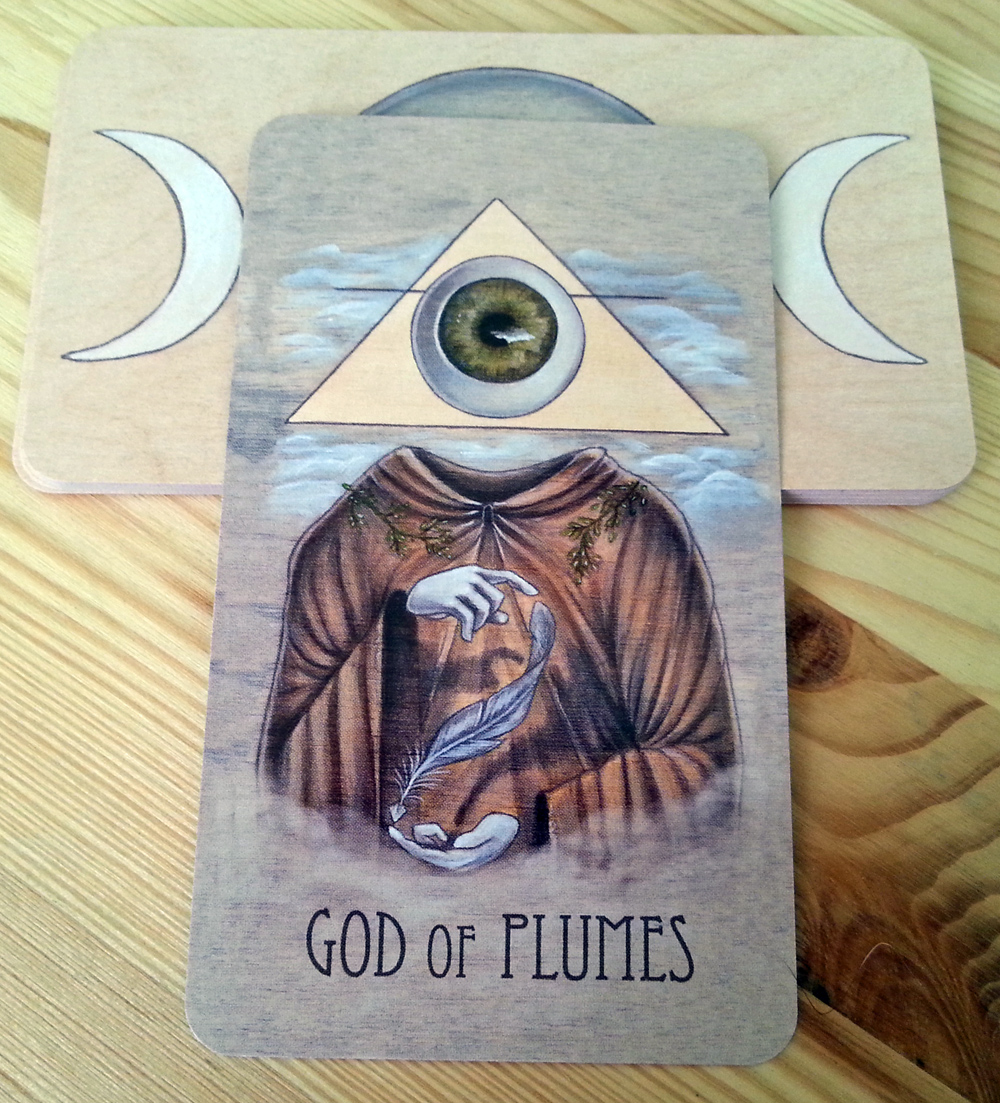This is part of an ongoing series in which I write about my interpretations of the cards in A.L. Swartz’s Wooden Tarot. You can find the other posts here.
Air/Swords/Plumes
In both the Suits of Stones and Plumes of the Wooden Tarot, it almost seems as if there are two suit symbols. In the case of Stones, both horns/antlers and gem-like stones appear with equal frequency. In this suit, Swartz has in some ways imaginatively fused together feathers and arrows.
Aside from Blooms, this is the suit symbol that makes the most sense to me intuitively. In the Collective Tarot, it’s called the Suit of Feathers; in the Wildwood Tarot, it’s called the Suit of Arrows. This is because of the suit’s association with air. This suit also has an association with pain and violence, but by using both feathers and arrows, Swartz has more flexibility in how he renders the cards.
Feathers in themselves are harmless enough, and we will see that in the lighter cards of the suit, like Four and Six, what we see are simply feathers. But feathers can also be used to guide deadly arrow shafts, keeping them on course, and so all of the arrows appearing on the cards have conspicuous feathered fletching.
Swartz does not take advantage of this association, but we could also think of plumes as the literal instrument of the intellect: the feather quill, used for so many centuries by people to write down their thoughts.
The God of Plumes
Dressed in a brown robe, the God of plumes holds a feather with a pointed arrow tip between their hands. Clouds appear in the background. Sprigs of greenery are placed around the God’s shoulders. An eye–directed slightly upwards–peers out from the alchemical suit for air: an upright triangle with a line through it.
We can tell this is an active, rather than receptive, suit because the God’s eye is slightly directed upward. Unlike the Gods of Blooms and Bones, who have fairly open hand gestures, the God of Plumes holds the suit symbol quite precisely between two fingers. The other fingers on their hands are curled inward. This suggests that this God values both being precise and playing things close to the vest.
I haven’t been able to figure out what the greenery around the God’s shoulders is. On first glance, I thought it was mistletoe, but that didn’t seem right. However, looking at pictures of mistletoe foliage makes me think that it is indeed mistletoe. Mistletoe, while associated with kissing at Christmas nowadays, was a sacred plant to the Druids and could be used for healing and to signify nonviolence. If this is mistletoe, it’s an interesting choice, but since I’m not sure I won’t unpack all of the implications.
The feather/arrow held by the God is the perfect emblem of the suit–lithe and graceful but also deadly much like the intellect, which can dazzle with its brilliance but cut to the bone. In some ways, I feel that the Wooden Tarot takes a balanced approach to the suit of air/swords, which can often be interpreted as mostly negative and is where tarot artists get their chance to practice gore if they like. The God of Plumes is an impartial figure, and what they hold in their hands can be used for good or ill. It’s important to remember that Major cards like Justice and the Star are also airy cards (in some systems) and that the intellect can be a very positive force in tarot.
Keys: an idea in its purest form–either a new idea or a thought experiment; the pursuit of knowledge for its own sake; a source of knowledge–anything from a gossipy friend to the library
Reversed: refusing to verify things factually; being in denial; ignorance
A God of Plumes Reading
The Eye: What insight is waiting for me about the role of intellect in my life?
The Bloom: What do I need to know?


Leave a Reply